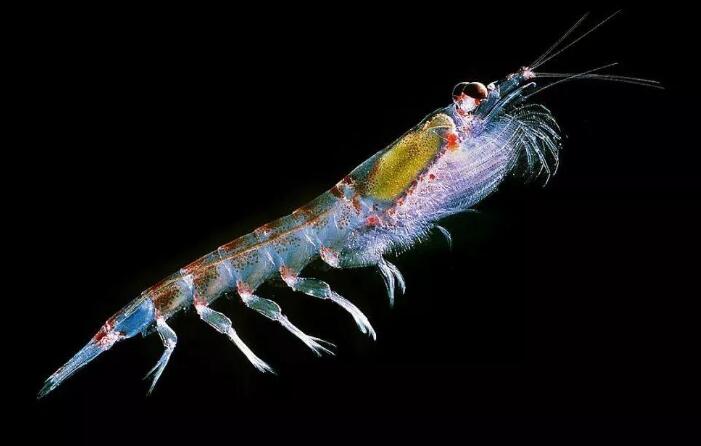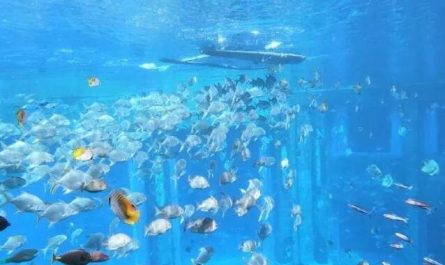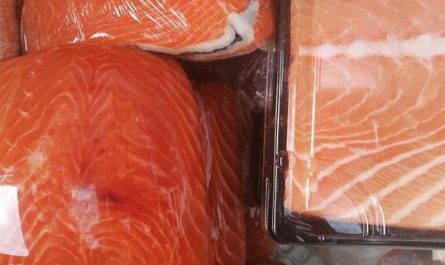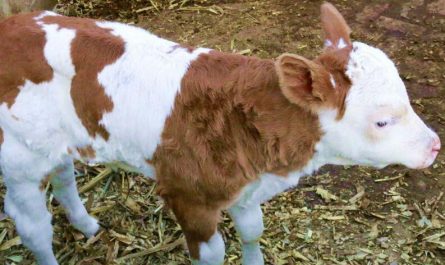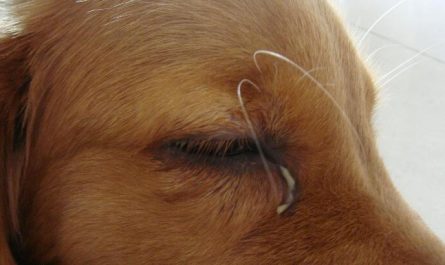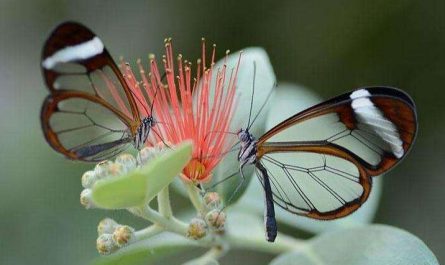The reason why krill glows
Because under the two eye stalks of the krill and most of the thoracic and gastropod bases, there is a spherical illuminator with a cell that can emit light in the center of the illuminator.
In the dark ocean, people can see a lot of “small bulbs” glowing, that is, krill swarms. Why is krill in Antarctic waters rich in food is the most important factor in controlling biomass. It is precisely because the Southern Ocean prepares an exceptionally rich food for krill-phytoplankton, and diatoms account for the largest proportion of phytoplankton, reaching 99% of the total phytoplankton in the entire Southern Ocean, which is the main food for krill. Especially near the Antarctic Convergence Zone, the number of diatoms is the largest, so the krill there grows very large. The body length of krill is 6-8 cm, and the shape is different from that of prawns, because its gills are exposed, unlike prawns that are covered with a carapace.
Its shape is similar to a transparent sea prawn in the Black Sea, with a slight reddish in blue and cyan. There is a reddish spherical light emitter in the body, which emits a beautiful blue-green phosphorescence at night, especially when fleeing after being frightened. Because most of the krill are floating on the surface of the sea, sometimes as they swim in groups, strange lights and colors appear on the sea, looking from a distance as if thousands of silver waves are rippling, a stream of fireflies flying together, adding to the night of Antarctica Mysterious colors. This kind of scenery, if viewed from a bird’s eye view on an airplane, often reminds people of the crystal palace of the sea dragon king in the mythical world.
Krill is the foundation of the Southern Ocean ecosystem and a key link in the Southern Ocean food chain. The reason why the Southern Ocean has abundant fish, seabirds, sea animals, etc., is because krill is extremely abundant. It is estimated that the marine birds of Antarctica consume 45 million tons of krill every year. The blue whale also eats 40 million tons of krill every year. Someone once took out a ton of krill from the belly of a blue whale he caught. Krill is a kind of shrimp, and its nutritional value is much higher than that of river shrimp. Biologists believe that it is the most protein-rich animal among marine organisms found. It is said that 10 krill are equivalent to the protein contained in half a catty of beef, and it can be used as a delicacy in a banquet.
In addition to food, krill can also be used as medicine, fertilizer and feed.
The appearance characteristics of krill
The general purpose of Euphausiacea real shrimp is 1 item. All marine zooplankton. With bifurcated finger-like gills and luminous organs, thoracic foot is not differentiated into jaw foot and step foot. There are 85 species known in the world, which can be divided into 2 families and 10 genera, 1 genus of Deep Krillaceae, and 9 genera of Krillaceae. More than 20 species have been reported in offshore China.
The appearance of krill resembles small decapod shrimp, with a body length of 6 to 95 mm. The body can be divided into cephalothorax and abdomen. The body segments of the cephalothorax are completely covered by the carapace, and the lower edges of both sides of the carapace are smooth or have lateral teeth. There are 7 segments in the abdomen, some species have spines or ridges on the back of the abdomen segment, and a pair of flaky spines on both sides of the end of the tail segment. There are 19 pairs of appendages, the first antenna is two-branch type, and the perch has 3 segments. The shape of each segment varies with species. The second antennae have developed scales. The incisor and molars of the mandible are directly connected, and the adult has no moving parts, but mostly has tentacles. The first limb of the first jaw has 2 segments, the outer side of the first segment expands into the outer limbs, and the inner lobe 1 is smaller. The second jaw has 2 segments, the inner limbs are not segmented, and the outer limbs are smaller, which is significantly different from the decapod. There are 8 pairs of thoracic limbs, basically similar, double-branched, 2 pro-limbs, branched foot gills at the base. There are 5 inner limbs, and the last 2 pairs or 1 pair are degenerated or completely absent. Among the second or third pair of thoracic legs in Nematoscelinae, 1 pair of inner limbs deforms into swept limbs. The base plate of the outer limbs is strong and the flagella is numerous. The inner and outer limbs have feathery bristles, and the ability to swim is strong. The inner limbs of the male’s 1st and 2nd abdominal limbs are deformed into the transfer device. The structure of the male is different from the species. Abdominal limbs are well developed, double-branch type.
The digestive tube of krill is relatively simple, and the branched liver and pancreas are digestive glands. The heart is polygonal, with 3 pairs of heart holes, and the blood circulation is open. The excretory organ is the antennal gland. Compound eyes are well developed and short stalk. The cornea of compound eyes of predatory species is often composed of two leaves of varying sizes. In addition to the genus Deep Krill, there are 5 to 10 light emitters. Generally on the top of the eyestalk, there is one each at the base of the second and seventh thoracic feet, and one in the center of the abdominal carapace of the first to fourth abdominal segments. Stylochecion belongs to only the eyestalk, the seventh thoracic limb and the first abdominal segment have 5 illuminators. The light-emitting device is composed of light-emitting cells, reflectors and crystals, all connected by nerves, and the structure on the eyestalk is different. Krill emits blue cold light.
Krill are dioecious and indirectly developed. Sperm is arranged in the sperm pod. The fertilized egg of the free-ovipositing species hatches into nauplii, and after two molts, it becomes the late nauplius; when the egg-carrying species hatches, it is the late nauplius; it molts into the nauplius and begins to feed, also divided into 3 In the third stage, the larvae molted as a bifurcated larvae, which can be divided into 4 stages; then they develop into a larvae, which is basically similar to the adult, except that the individual is small and sexually immature. This stage is actually the juvenile stage.
The feeding habits of krill vary with age. The larvae filter on diatoms and organic debris, while the adults prey on copepods and other small zooplankton. Filter-feeding species consist of bristles on the thoracic limbs to form filters. When the omnivorous species changes from filter feeding to predation, the filtration rate is greatly reduced. The predatory species generally have developed second or third thoracic limbs. The respiration rate of krill is usually proportional to its body surface area. Cold water krill has a longer life cycle. In the Sea of Okhotsk, krill grow faster in the first year, and then gradually slow down. The growth period of krill is consistent with the spring and autumn peaks of diatoms. But when the ovaries mature, growth almost stops. The reproductive capacity increases with age (body length), but after a certain age, the egg production decreases. The development rate varies from species to species. For example, the Norwegian krill nauplius takes 3 to 4 days, while the tasseled krill takes 7 to 9 days. The female Antarctic krill takes 25 months to develop to sexual maturity (males need 22 Months). Krill often clusters in large numbers, and they have the habit of vertical movement day and night in the water body, rising to the surface of the water at night and descending in the morning.
The living habits of krill
The esophagus of Antarctic krill is green when seen from its transparent shell. It can be seen that they mainly feed on phytoplankton, especially small diatoms (about 20 microns). Diatoms will be ground by its stomach cavities and digested in the liver and pancreas. Antarctic krill can also prey on copepods, amphipods and other small zooplankton. Its esophagus is a straight tube, and its digestive efficiency is not too high, so its feces still have a lot of carbon.
In the aquarium, it was found that Antarctic krill would eat each other. When they are not fed in the aquarium, they will shed their shells and shrink in size, which other animals do not have. This may be their adaptation to food supply restrictions in winter.
